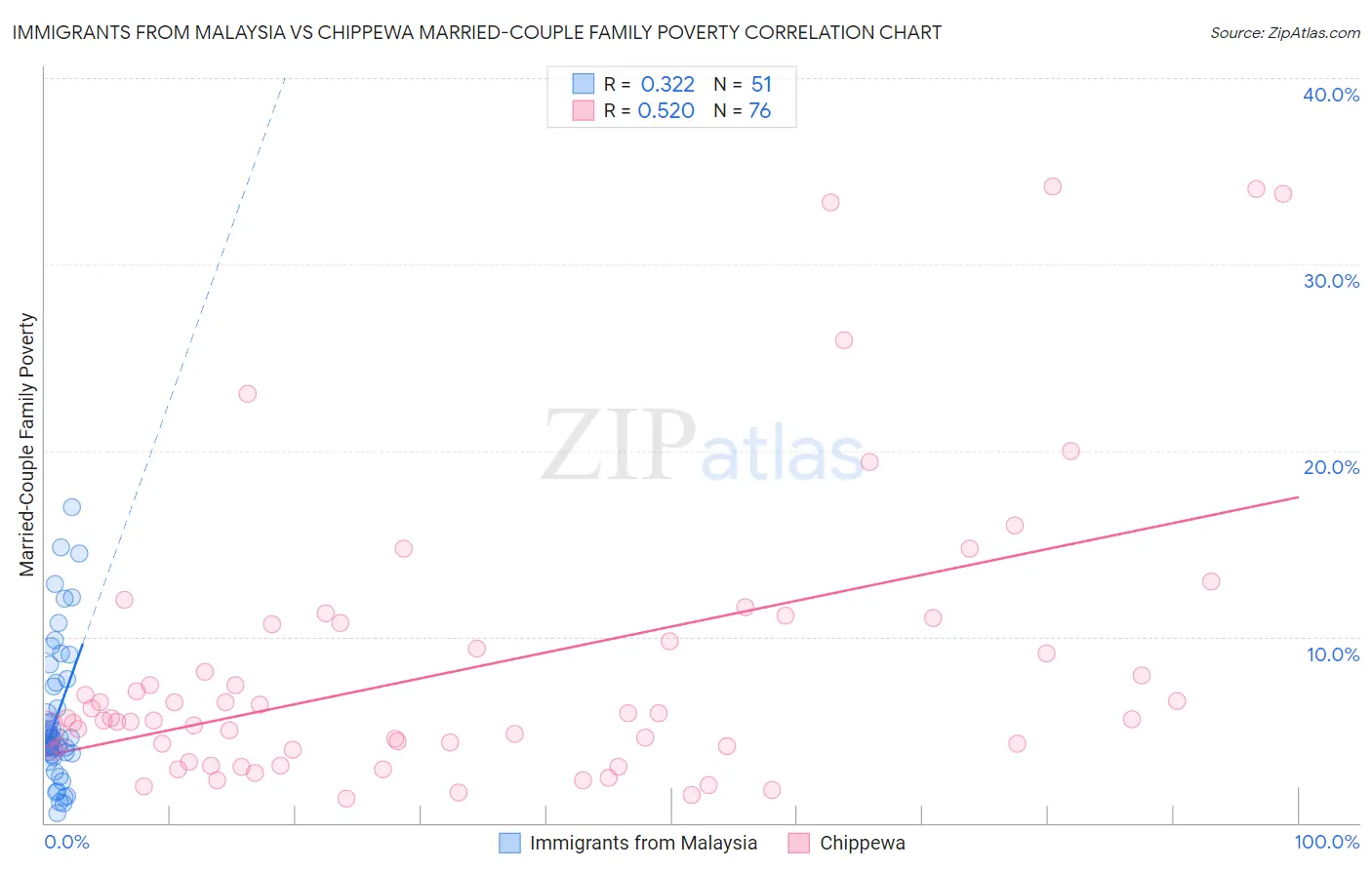Immigrants from Malaysia vs Chippewa Married-Couple Family Poverty
COMPARE
Immigrants from Malaysia
Chippewa
Married-Couple Family Poverty
Married-Couple Family Poverty Comparison
Immigrants from Malaysia
Chippewa
5.1%
MARRIED-COUPLE FAMILY POVERTY
62.2/ 100
METRIC RATING
165th/ 347
METRIC RANK
5.4%
MARRIED-COUPLE FAMILY POVERTY
18.9/ 100
METRIC RATING
205th/ 347
METRIC RANK
Immigrants from Malaysia vs Chippewa Married-Couple Family Poverty Correlation Chart
The statistical analysis conducted on geographies consisting of 197,184,405 people shows a mild positive correlation between the proportion of Immigrants from Malaysia and poverty level among married-couple families in the United States with a correlation coefficient (R) of 0.322 and weighted average of 5.1%. Similarly, the statistical analysis conducted on geographies consisting of 213,662,644 people shows a substantial positive correlation between the proportion of Chippewa and poverty level among married-couple families in the United States with a correlation coefficient (R) of 0.520 and weighted average of 5.4%, a difference of 5.8%.

Married-Couple Family Poverty Correlation Summary
| Measurement | Immigrants from Malaysia | Chippewa |
| Minimum | 0.54% | 1.3% |
| Maximum | 16.9% | 34.1% |
| Range | 16.4% | 32.9% |
| Mean | 5.8% | 8.4% |
| Median | 4.6% | 5.6% |
| Interquartile 25% (IQ1) | 3.6% | 4.0% |
| Interquartile 75% (IQ3) | 7.7% | 10.2% |
| Interquartile Range (IQR) | 4.1% | 6.2% |
| Standard Deviation (Sample) | 3.8% | 7.8% |
| Standard Deviation (Population) | 3.8% | 7.7% |
Similar Demographics by Married-Couple Family Poverty
Demographics Similar to Immigrants from Malaysia by Married-Couple Family Poverty
In terms of married-couple family poverty, the demographic groups most similar to Immigrants from Malaysia are Hawaiian (5.1%, a difference of 0.010%), Paraguayan (5.1%, a difference of 0.090%), Costa Rican (5.1%, a difference of 0.090%), Sierra Leonean (5.1%, a difference of 0.25%), and Immigrants from Jordan (5.1%, a difference of 0.56%).
| Demographics | Rating | Rank | Married-Couple Family Poverty |
| Immigrants | South Eastern Asia | 70.4 /100 | #158 | Good 5.1% |
| Immigrants | Saudi Arabia | 70.3 /100 | #159 | Good 5.1% |
| Pennsylvania Germans | 68.5 /100 | #160 | Good 5.1% |
| Ethiopians | 68.1 /100 | #161 | Good 5.1% |
| Immigrants | Jordan | 66.5 /100 | #162 | Good 5.1% |
| Sierra Leoneans | 64.1 /100 | #163 | Good 5.1% |
| Hawaiians | 62.3 /100 | #164 | Good 5.1% |
| Immigrants | Malaysia | 62.2 /100 | #165 | Good 5.1% |
| Paraguayans | 61.5 /100 | #166 | Good 5.1% |
| Costa Ricans | 61.5 /100 | #167 | Good 5.1% |
| Immigrants | Uganda | 54.9 /100 | #168 | Average 5.2% |
| Ottawa | 54.5 /100 | #169 | Average 5.2% |
| Immigrants | Argentina | 54.4 /100 | #170 | Average 5.2% |
| Bermudans | 52.9 /100 | #171 | Average 5.2% |
| Immigrants | Northern Africa | 51.3 /100 | #172 | Average 5.2% |
Demographics Similar to Chippewa by Married-Couple Family Poverty
In terms of married-couple family poverty, the demographic groups most similar to Chippewa are Immigrants from Costa Rica (5.4%, a difference of 0.080%), Osage (5.4%, a difference of 0.10%), Immigrants from Africa (5.5%, a difference of 0.24%), Immigrants from Peru (5.4%, a difference of 0.49%), and French American Indian (5.5%, a difference of 0.56%).
| Demographics | Rating | Rank | Married-Couple Family Poverty |
| Immigrants | Belarus | 26.2 /100 | #198 | Fair 5.4% |
| Uruguayans | 25.0 /100 | #199 | Fair 5.4% |
| Immigrants | Morocco | 24.3 /100 | #200 | Fair 5.4% |
| Lebanese | 24.1 /100 | #201 | Fair 5.4% |
| Immigrants | Middle Africa | 23.8 /100 | #202 | Fair 5.4% |
| Immigrants | Peru | 21.8 /100 | #203 | Fair 5.4% |
| Immigrants | Costa Rica | 19.4 /100 | #204 | Poor 5.4% |
| Chippewa | 18.9 /100 | #205 | Poor 5.4% |
| Osage | 18.4 /100 | #206 | Poor 5.4% |
| Immigrants | Africa | 17.6 /100 | #207 | Poor 5.5% |
| French American Indians | 16.1 /100 | #208 | Poor 5.5% |
| Immigrants | Syria | 15.4 /100 | #209 | Poor 5.5% |
| Immigrants | Micronesia | 14.4 /100 | #210 | Poor 5.5% |
| Nigerians | 14.3 /100 | #211 | Poor 5.5% |
| Immigrants | Thailand | 14.0 /100 | #212 | Poor 5.5% |